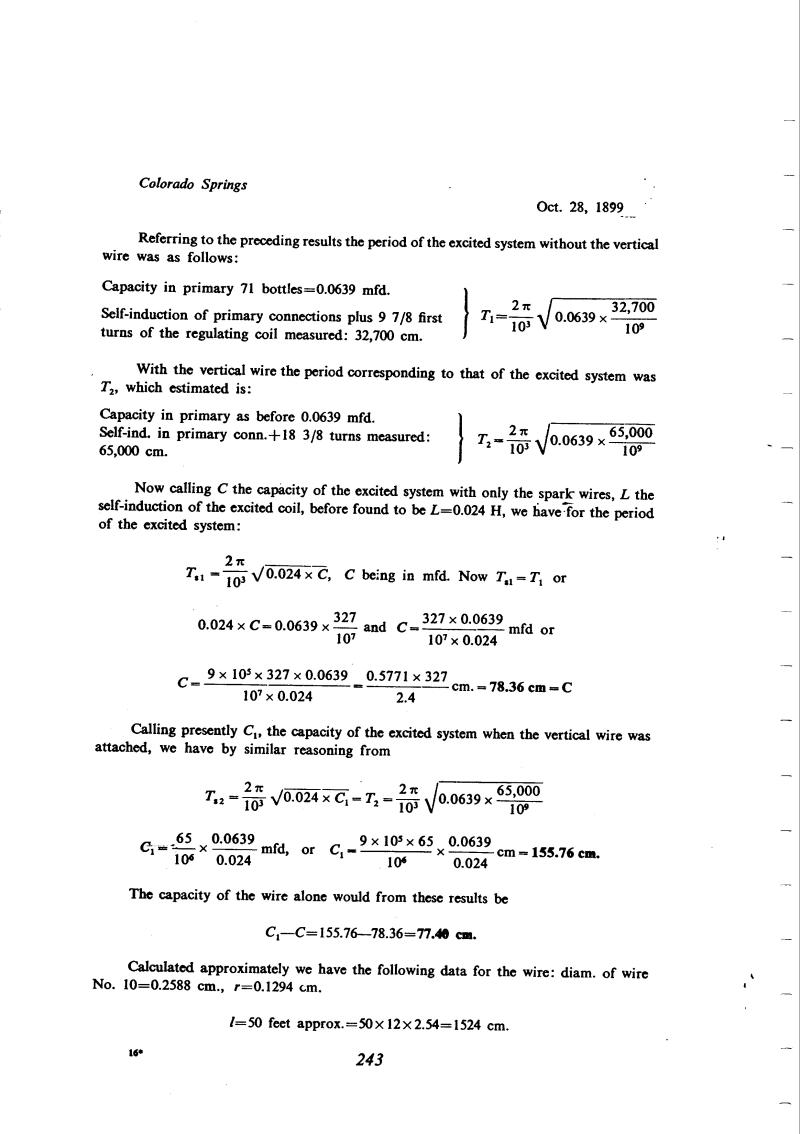
Nikola Tesla Books
Colorado Springs
Oct. 28, 1899
Referring to the preceding results the period of the excited system without the vertical wire was as follows:
| Capacity in primary 71 bottles = 0.0639 mfd. | } | $! {T_{1} = {{2 \pi \over 10^{3}} \sqrt{0.0639 \times {32,700 \over 10^{9}}}}} $! |
| Self-induction of primary connections plus 9 7/8 first turns of the regulating coil measured: 32,700 cm. |
With the vertical wire the period corresponding to that of the excited system was T2, which estimated is:
| Capacity in primary as before 0.0639 mfd. | } | $! {T_{2} = {{2 \pi \over 10^{3}} \sqrt{0.0639 \times {65,000 \over 10^{9}}}}} $! |
| Self-ind. in primary conn. + 18 3/8 turns measured: 65,000 cm. |
Now calling C the capacity of the excited system with only the spark wires, L the self-induction of the excited coil, before found to be L = 0.024 H, we have for the period of the excited system:
$! {{{T_{s}}_{1} = {{2 \pi \over 10^{3}} \sqrt{0.024 \times C_{1}}}}} $! C being in mfd. Now Ts1 = T1 or
$! {0.024 \times C = 0.0639 \times {327 \over 10^{7}}} $! and $! {C = {{327 \times 0.0639} \over {10^{7} \times 0.024}}} $! mfd or
$! {C = {{9 \times 10^{5} \times 327 \times 0.0639} \over {10^{7} \times 0.024}} = {{0.5771 \times 327} \over 2.4} \text{ cm}} $! = 78.36 cm = C
Calling presently C1, the capacity of the excited system when the vertical wire was attached, we have by similar reasoning from
$! {{T_{s}}_{2} = {{2 \pi \over 10^{3}} \sqrt{0.024 \times C_{1}}} = T_{2} = {{2 \pi \over 10^{3}} \sqrt{0.0639 \times {65,000 \over 10^{9}}}}} $!
$! {C_{1} = {{65 \over 10^{6}} \times {0.0639 \over 0.024}} \text{ mfd}} $!, or $! {C_{1} = {{{9 \times 10^{5} \times 65} \over 10^{6}} \times {0.0639 \over 0.024}} \text{ cm}} $! = 155.76 cm.
The capacity of the wire alone would from these results be
C1 - C = 155.76 - 78.36 = 77.40 cm.
Calculated approximately we have the following data for the wire: diam. of wire No. 10 = 0.2588 cm., r = 0.1294 cm.
l = 50 feet approx. = 50 x 12 x 2.54 = 1524 cm.
16*
243
Tesla: âOn electricityâ, EL Rev. Jan. 27, 1897, A-101.
October 28
After several days gathering data and making further measurements of inductance and capacitance, he finally proceeds to the calculation of the unknown capacity of the sphere, using the readings of October 23rd and 26th. Consistent with his general principle, he checked the measured values by (usually approximate) calculations.
He calculates the capacitance of the vertical wire by the formula for an isolated ellipsoid of high eccentricity. It is not known whether Tesla first had the idea of using this formula, but it was used later for a similar purpose(58). All things considered, the agreement between the calculated and measured values is very good.
Tesla then calculated the ratio of the capacities in the lowest and highest positions. In the lowest position the sphere makes little difference to the total capacity. In the highest position it increases the capacity in the coil circuit by 18.7 cm. This is less than the theoretical value for an isolated sphere of 18" diameter, which does not agree with some of his earlier measurements (see the results of October 21st for a 30" ball). However, if a comparison is to be made, it must be noted that the new results are probably better because the apparatus had been modified and the parameters checked.
October 28
After collecting data for several days and performing additional measurements of inductance and capacitance, he finally calculated the known sphere capacitance. He takes the values measured on Oct. 23 and 26. Following his working method he checks the measured values (most frequently approximate ones) by calculation.
The vertical wire capacitance he calculates by means of the equation for the single elipsoid capacitance with high axis ratio. We don't know where Tesla came up with the idea to use this equation but it is known that it has been applied later for a similar purpose(58). Based on all these circumstances, the matching between measure and calculated value is indeed very good. Further calculations are related to sphere capacitance in the lowest and highest elevation. In the lowest position the sphere contributes very little to the capacitance increase. In the highest position the globe increases the capacitance in coil L circuit by 18.7 cm. This value is smaller than the theoretical capacitance value for the separate sphere of 18" diameter, which does not correspond with some previous Tesla measurements (please see results of Oct. 21 for a globe 30" in diameter). When we compare the results, it has to be emphasized that the new results are likely better because measurements were performed with changed apparatus and checked parameters.

